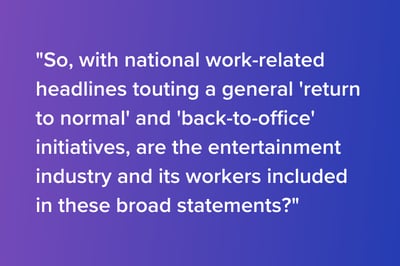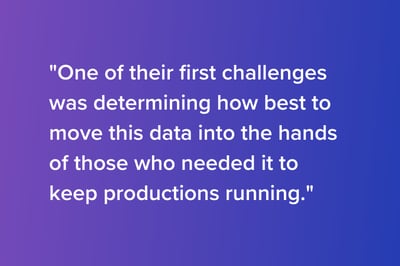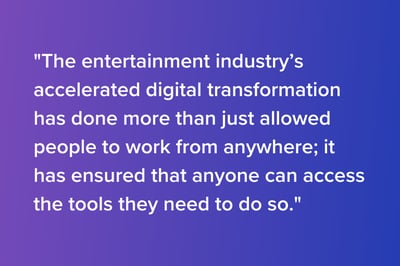The entertainment industry looks completely different today than one might have expected just a few years ago. While many practices have shifted out of recent necessity, the industry successfully worked its way around a global pandemic and managed to thrive. How was this possible? It’s simple: entertainment bounced back because hungry audiences were still there. Of  course, circumstances made them a bit less mobile than before, leading to the prioritization of on-demand home delivery. With your home as entertainment’s new epicenter, movies are being distributed directly into your living room. By now, this flow seems normal to many of us, both audiences and creators alike. So, with national work-related headlines touting a general “return to normal” and “back-to-office” initiatives, are the entertainment industry and its workers included in these broad statements?
course, circumstances made them a bit less mobile than before, leading to the prioritization of on-demand home delivery. With your home as entertainment’s new epicenter, movies are being distributed directly into your living room. By now, this flow seems normal to many of us, both audiences and creators alike. So, with national work-related headlines touting a general “return to normal” and “back-to-office” initiatives, are the entertainment industry and its workers included in these broad statements?
It's fair to say that the biggest changes to entertainment production infrastructure happened behind the scenes. With many films and television shows keeping or simply pushing their scheduled releases during the pandemic, audience inconvenience was mostly relegated to having to wait. This helped maintain a certain level of normalcy from the outside. However, the industry itself had to adapt its entire infrastructure in order to survive, let alone thrive. For example, take the simple management of production data and elements. When the pandemic first hit, many workers were hit with the hard realization that all of their data was sitting siloed in their offices. One of their first challenges was determining how best to move this data into the hands of those who needed it to keep productions running.
During the “Future of Work” panel at last year’s Infinity Festival, television editor AJ Catoline shared his experience working on Apple’s Ted Lasso, including his rush to buy as many physical hard drives as he could find in order to save the show’s post-production workflow. The pandemic-era demand for physical storage quickly forced the industry to look toward cloud storage as a more sustainable, long-term solution. As lockdowns went into effect early in the pandemic, it became clear that no one would be going into the office for a while. For productions, physical hard drives ultimately translated to risk—anything saved only to a single location, and which is not accessible to more than one employee, is vulnerable to disaster. For example, if a television editor’s power goes out, there is no way to finish and distribute their current episode. With all these concerns forced to the forefront, the entertainment industry quickly shifted its attention toward digital solutions, and it is now embracing an ecosystem of data centers which are connected to the cloud from multiple locations, emphasizing the importance of faster movement.
AJ Catoline shared his experience working on Apple’s Ted Lasso, including his rush to buy as many physical hard drives as he could find in order to save the show’s post-production workflow. The pandemic-era demand for physical storage quickly forced the industry to look toward cloud storage as a more sustainable, long-term solution. As lockdowns went into effect early in the pandemic, it became clear that no one would be going into the office for a while. For productions, physical hard drives ultimately translated to risk—anything saved only to a single location, and which is not accessible to more than one employee, is vulnerable to disaster. For example, if a television editor’s power goes out, there is no way to finish and distribute their current episode. With all these concerns forced to the forefront, the entertainment industry quickly shifted its attention toward digital solutions, and it is now embracing an ecosystem of data centers which are connected to the cloud from multiple locations, emphasizing the importance of faster movement.
With this new workflow comes the need for better connectivity and accessibility. Since editors are no longer necessarily going to the office to work, raw content must now be delivered to them. Production workflows that were once rigidly mapped out from pre-production through post-production now demand a more adaptive timeline in which post work no longer waits for the completion of principle production. The future of the industry is more of a simultaneous world with workflows that are non-dependent on the environment.
Asynchronous workflows became the pandemic standard, using low-resolution footage to boost the upload latency caused by raw, high-res dailies. This new mindset identified inefficiencies within the production workflow that were based on antiquated techniques. Remote working, which was rare before the pandemic, is now possible (and, in fact, common!) with the use of proxies that decrease file transfer delays and centralized databases that connect workstations to the cloud—things that many executives have wanted to tap into for a while. As Adam Slohn (Strategic Advisor at Dark Fiber Production Technology and former VP, Production Systems at Warner Bros) discussed in our coverage of the studio perspective, the industry has had its eye on the cloud for a while. In fact, this post from 2018 includes our technology team discussing the benefits of a unified cloud platform.
As the industry works toward a unified standard, Cast & Crew is already providing tools that help simplify the lives of production accountants, such as digital solutions for onboarding, timecards, payroll, expenses, and accounting. The Covid-19 pandemic has amplified calls for centralization in production and the need to get rid of data silos, assuring that all aspects of production are more accessible to talent. Cast & Crew is already at the forefront of this movement, providing a suite of robust digital workflow solutions such as Studio+, Hours+, Start+, and PSL+. Our software solutions directly address key production pain points, empowering creators to focus on the things that really matter.
 The entertainment industry’s accelerated digital transformation has done more than just allowed people to work from anywhere; it has ensured that anyone can access the tools they need to do so. This democratization is not only simplifying production, but also opening doors to even more creativity. Not long ago, industry leaders across the nation were looking at Hollywood as an inspiration for their future work. In this 2016 article from Fast Company, Stephane Kasriel, former CEO of Upwork, noted that all work would soon value individual talent and ideas, making flexibility the key to overcoming talent shortages (something Hollywood has understood since the Supreme Court’s 1948 decision on vertical integration led to the decline of the early studio system). The entertainment and media industries have always been admired for their creativity and storytelling. And now, we’re in our very own future-thought movement, which is demanding that everyone try to re-imagine traditional standards and ways of working as newer technologies are integrated.
The entertainment industry’s accelerated digital transformation has done more than just allowed people to work from anywhere; it has ensured that anyone can access the tools they need to do so. This democratization is not only simplifying production, but also opening doors to even more creativity. Not long ago, industry leaders across the nation were looking at Hollywood as an inspiration for their future work. In this 2016 article from Fast Company, Stephane Kasriel, former CEO of Upwork, noted that all work would soon value individual talent and ideas, making flexibility the key to overcoming talent shortages (something Hollywood has understood since the Supreme Court’s 1948 decision on vertical integration led to the decline of the early studio system). The entertainment and media industries have always been admired for their creativity and storytelling. And now, we’re in our very own future-thought movement, which is demanding that everyone try to re-imagine traditional standards and ways of working as newer technologies are integrated.
In the next installment of this Future of Work series, we will continue to look at what's ahead by understanding the challenges we face, the technologies we need to adopt, and the new opportunities that will accelerate creation and lead to jobs across entertainment.
.png)
